Pepper Grinder is a mechanically unusual platformer. I play as Pepper, the only apparent survivor of a shipwreck, who awakens on a beach to find her waterlogged treasure has been stolen by Narlings, a toothy combination of goblins and narwhals. Commanded by the black knight Mint, the Narlings gather Pepper’s treasure in a chest and carry it inland. Pepper’s attempt to stop them is an embarrassing failure, but happenstance places her hands on a tool called a Grinder, a drill that propels its holder through soft earth like a diver gripping a jet engine in water. Using the Grinder, Pepper pursues the thieves through nineteen platforming levels and four boss fights, growing closer to the Narlings’ ominous base with every piece of treasure she recovers.
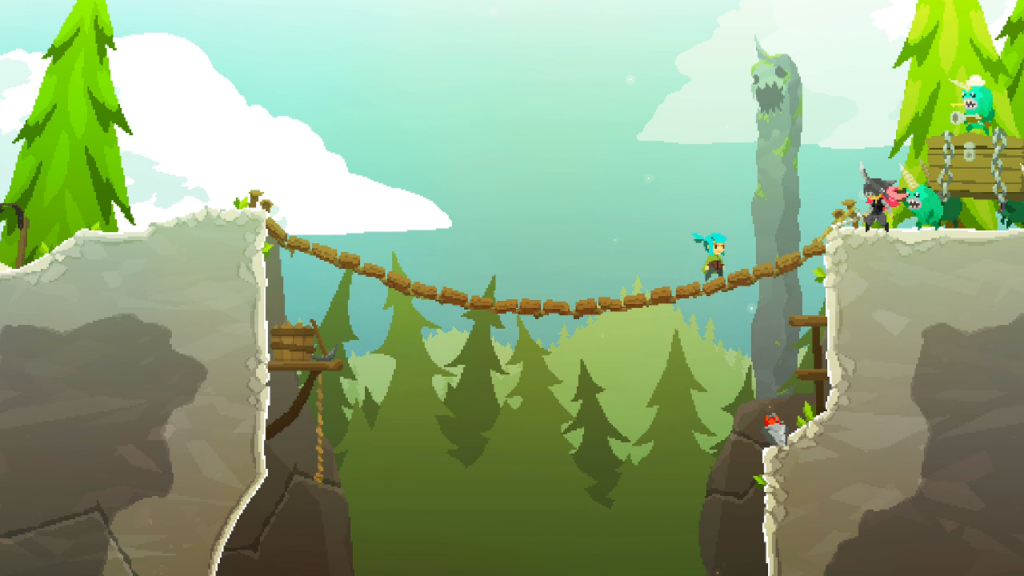
I refer to Pepper Grinder as a platformer for simplicity’s sake. While many of the obstacle courses Pepper overcomes are designed around jumps across suspended platforms, most of her adventure is built upon the Grinder’s unique abilities. By holding down a button, I direct Pepper to activate the Grinder’s drill. This can be used offensively against the Narlings which crawl across almost every level, free valuable gems trapped in the surface of rock walls, and most importantly, send Pepper gliding through sand, snow, soil, and any other kind of soft earth, rocketing towards each level’s distant conclusion on its far right side.
The Grinder’s unique movement properties are where Pepper Grinder derives its most intricate level design. While Pepper is pulled through the earth, I can give her a short burst of speed with the press of the jump button. When I point Pepper out of the earth, this burst sends her flying into the air, much higher than her legs can carry her, propelling her up to out-of-reach platforms, through trails of lost treasure suspended impossibly in midair by videogame physics, and in the best moments, from one tunnel of soft earth into another.
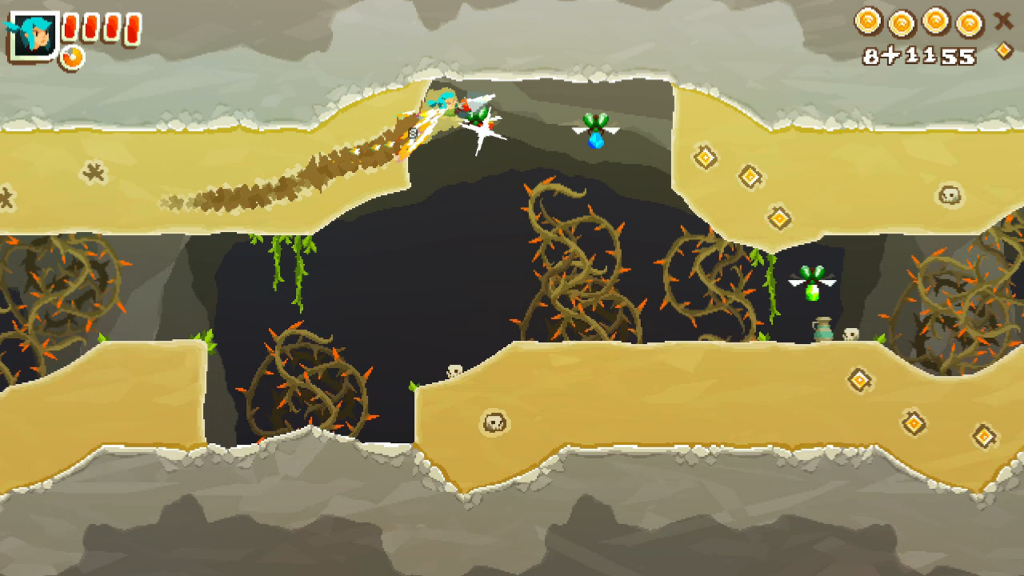
Though the use of the Grinder’s momentum to send Pepper flying across levels results in some of the year’s best platforming so far, it is wisely not the only trick in her bag. Later levels add grappling points Pepper can grab onto with a rope and hook. Some let her spin in endless, dizzying circles until I thrust her away with a spin from the Grinder. Others are placed precariously at the ends of tunnels, requiring split-second timing as Pepper leaves the soft earth to send her flinging up to the next.
If I do mistime a grapple, my penalty is minimal; falling into a pit causes Pepper to reappear at the last solid ground she stood upon with a missing hit point. Running out of hit points isn’t a concern. Checkpoints are numerous and continues infinite.
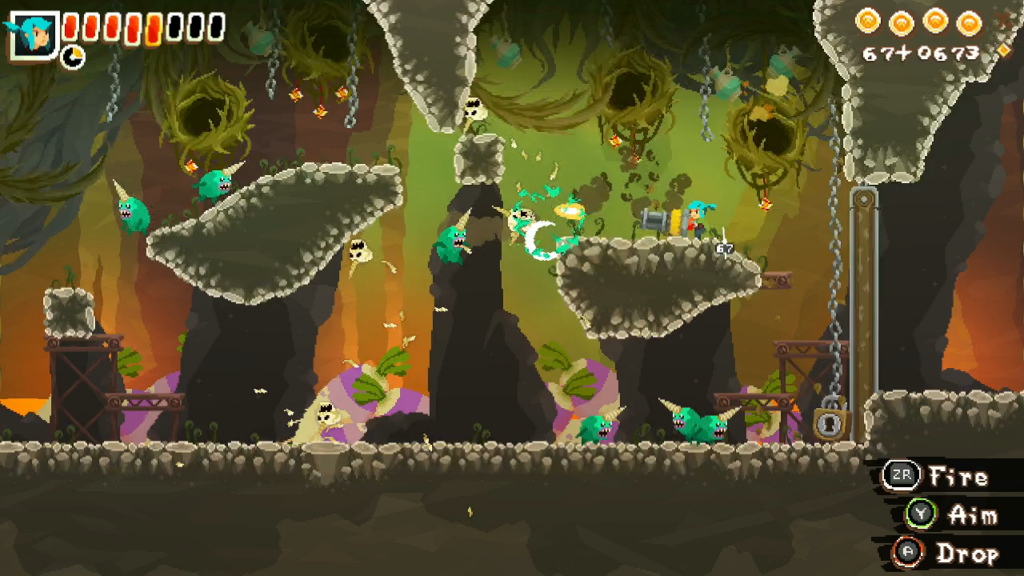
In a few levels, the Grinder also acts as a controller for other machines. Pepper can insert it into a small cannon which is conveniently placed just before areas containing an army of Narlings. For a few minutes, Pepper Grinder is transformed into a side-scrolling shooter for a few minutes. By allowing Pepper to point the cannon in any direction and unleash a barrage of automatic gunfire, these sequences become as frenetic as Contra or Metal Slug. One late shooting sequence even includes a traditional elevator ride while Narlings swarm Pepper from all directions.
Another device that can be manipulated with the Grinder is a giant robot. Pepper can steer the robot into jumps and forward charges, smashing structures that get in its way like a kaiju rampaging through a city. In contrast to the rest of the videogame where Pepper must defend herself from the Narlings, once she is plugged into the robot she becomes invulnerable and unstoppable. It’s an expression of sheer, satisfying power cut disappointingly short when Pepper inevitably encounters a passage too small for the robot to enter.
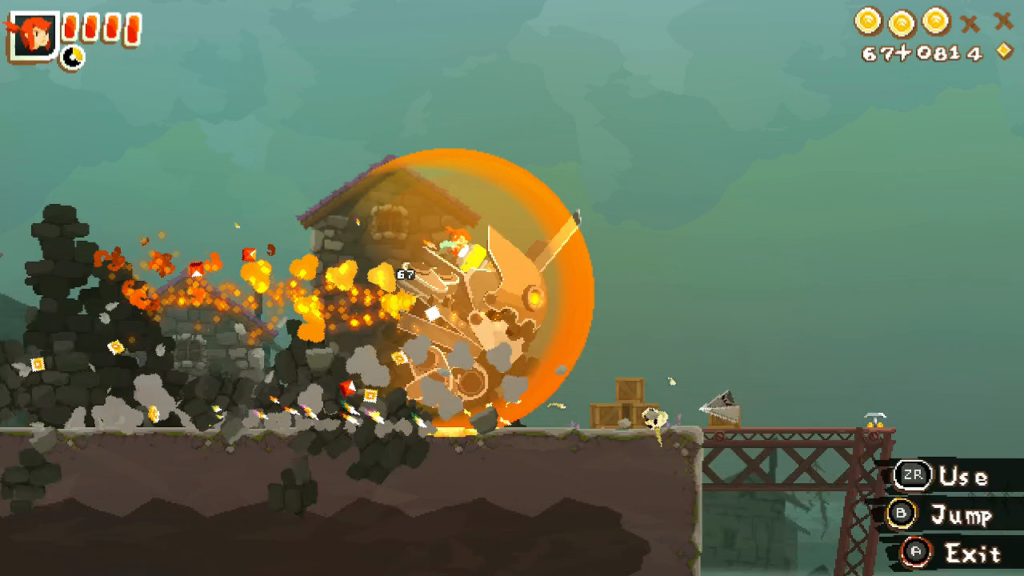
While brief and not containing enough depth to support an entire videogame, these device sequences are welcome breaks before Pepper Grinder returns to its usual high-speed and high-flying platforming design.
The Grinder’s unique movement abilities are leveraged as cleverly in Pepper Grinder’s boss fights as they are in platforming. As with the platforming, each boss requires Pepper to burrow through soft earth to avoid attacks and reach weak points.
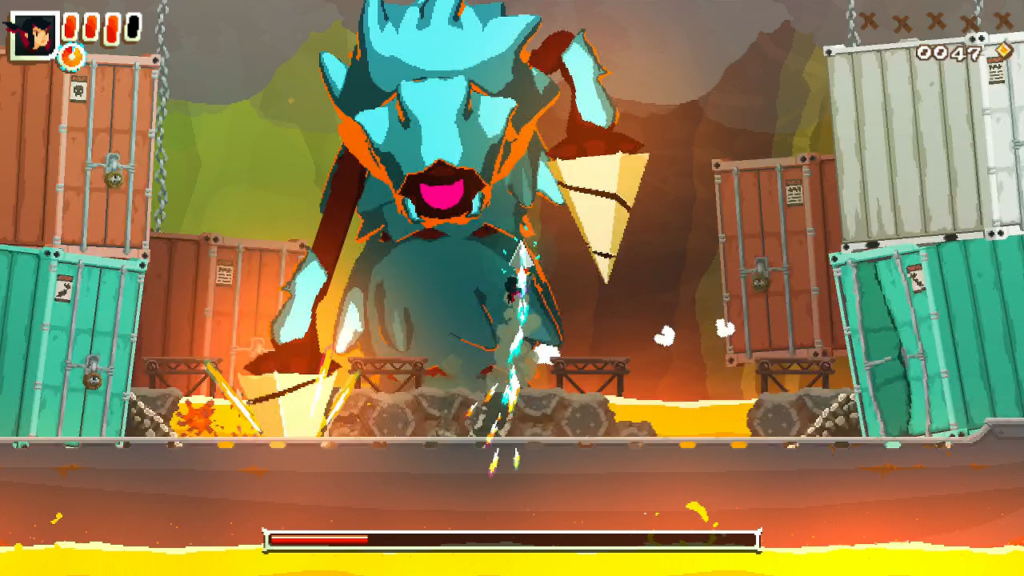
How exactly this happens is distinct in each boss fight. Against a giant beetle, Pepper uses the Grinder to reach her foe’s vulnerable underside, even when the beetle crawls up to the walls and ceiling. A robotic centipede fought in a molten scrap yard requires as much care as speed; Pepper must burrow through molten rock to gain the momentum needed to reach the centipede’s vulnerable eye, all while the centipede uses its drill arms to stir the rock into blazing lava. The fight against the black knight Mint is the most interesting. As Pepper’s evil counterpart and wielding a pair of Grinders of her own, Mint turns many of the tricks Pepper relies on back against her. In contrast to the other giant-sized bosses Pepper fights, Mint is a challenging and diminutive opponent who fights with skill and guile instead of brute strength.
I don’t learn many specific details about this adventure. Who exactly Pepper is, where she got her treasure, and how her ship crashed are all questions that go unanswered. It’s not even clear that the treasure is really Pepper’s or that she was a welcome passenger on the ship. It’s likely that she is a pirate who has no more right to the treasure than Mint and the Narlings. I will never have answers to these questions as Pepper’s entire quest is portrayed with as few words as possible. Core concepts like jumping, drilling, and grappling are related through pictographs. Every other part of Pepper Grinder’s setting and characterization is communicated through implication. The only visible words are level names and they are not required to understand the videogame.
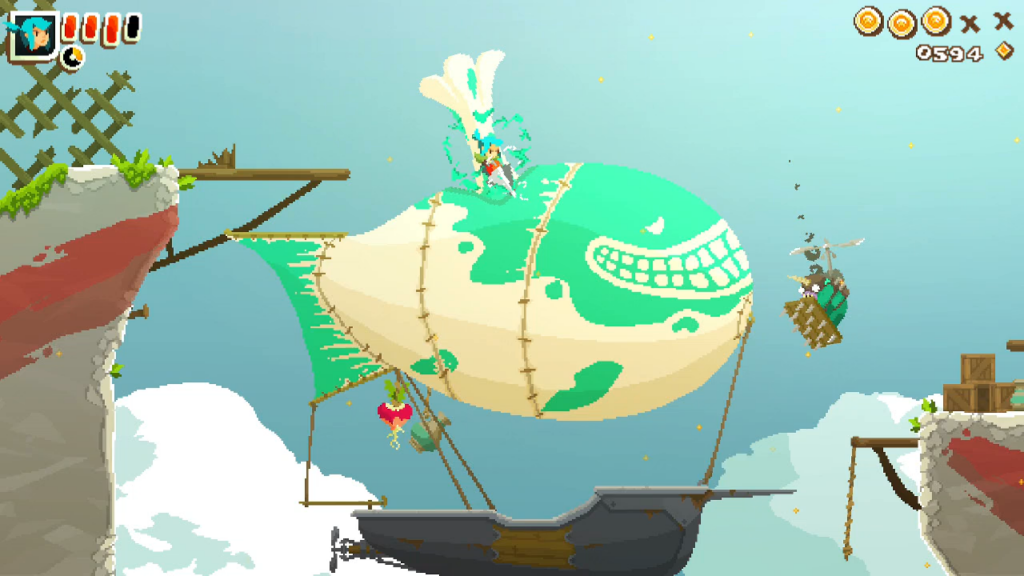
There’s great variety in Pepper Grinder’s settings. The early beach levels are the simplest in concept and gentlest in difficulty, yet still provide unique sights like an armada of blimps suspended in the sky. Pepper can pop their bladders with the Grinder, pushing them up or down to make platforming easier. The second set of levels sends Pepper through a volcanic wasteland that slowly transforms into the Narling’s garbage dump. One level here is a kind of Narling cookery, with giant steak slabs hanging from hooks Pepper can drill through and stew pots swinging from hooks she can jump across. Ideas both visual and mechanical are rarely repeated, preventing them from becoming stale.
This originality is enabled by Pepper Grinder’s brevity. It doesn’t take much time at all to finish all nineteen levels. When I am done and the credits roll, I immediately wish for more to do.
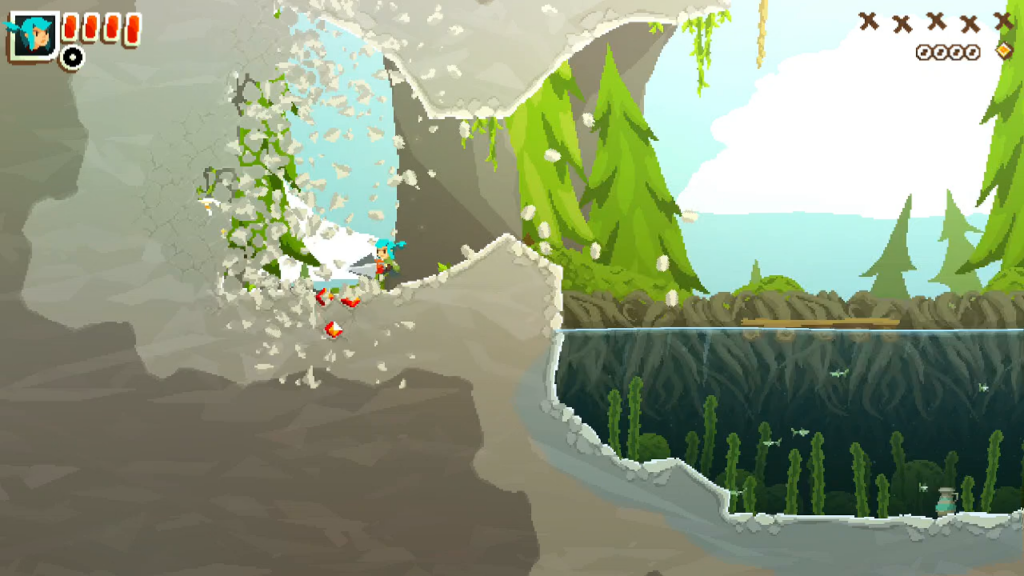
To inject a little more longevity, I am given some reason to revisit the existing levels. In addition to standard treasure, each level contains five special coins. Most of these are secreted behind walls which have a crumbling pattern on them distinct from the rest of the environment. It’s easy to miss these patterns when Pepper flies past them at full speed, sometimes requiring a level to be played multiple times to spot them all. Other coins only appear when Pepper gathers a string of treasure or enters an isolated alcove.
Another reason to revisit levels is for time trial challenges. Every level, even boss fights, may be replayed to push for a best clear time. Earning a gold trophy in a level requires foreknowledge of the level’s layout and masterful execution of Pepper’s skillset. There is no room to make a single mistake and I won’t fumble my way into a winning time. The time trials are Pepper Grinder at its most demanding and challenging.
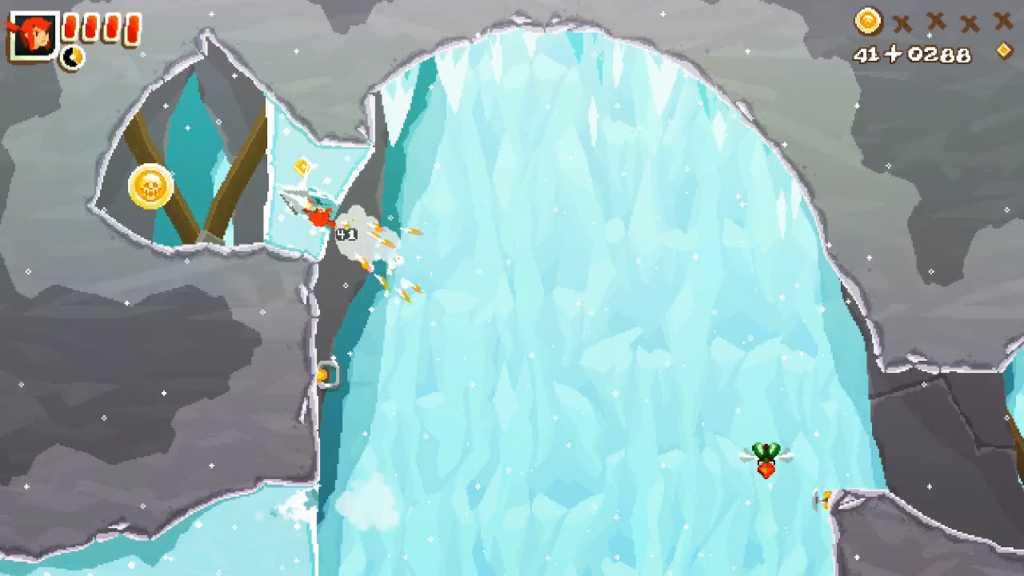
I appreciate the effort to make Pepper Grinder into a more substantial videogame through these extra challenges, but they are only able to extend the experience for so long. I am able to beat every level and find every hidden gold coin in less than four hours. Earning time trial golds about doubles that playtime.
My desire for there to be more reflects how much I admire what is here. Normally I compliment a videogame for conciseness, and Pepper Grinder is the year’s best and most imaginative platformer so far. I find myself disappointed because what is here is so well crafted and yet so brief.
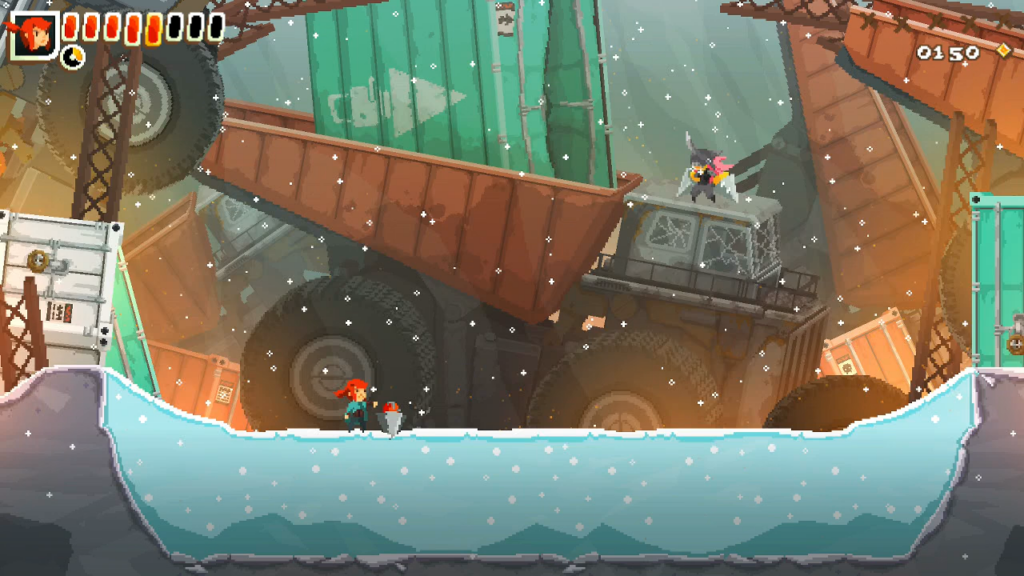
Pepper Grinder has all the right elements to be an incredible platformer. The Grinder creates an interesting twist on traditional platforming. Individual levels exploit its mechanics to create fun and unique challenges in original environments while level design teaches me mechanics without resorting to unnecessary text. This show-don’t-tell approach is reflected in the storytelling, which does a wonderful job of balancing fantasy against ambiguity, creating a world without dictating to me the role Pepper plays within it. My only qualm is its length. Normally I mark brevity as a strength, but Pepper Grinder is so good I wish it was much longer. Its ending arrives with sudden disappointment instead of triumphant satisfaction. If that’s the worst I can say of it, then Pepper Grinder guarantees its spot as one of 2024’s best videogames.